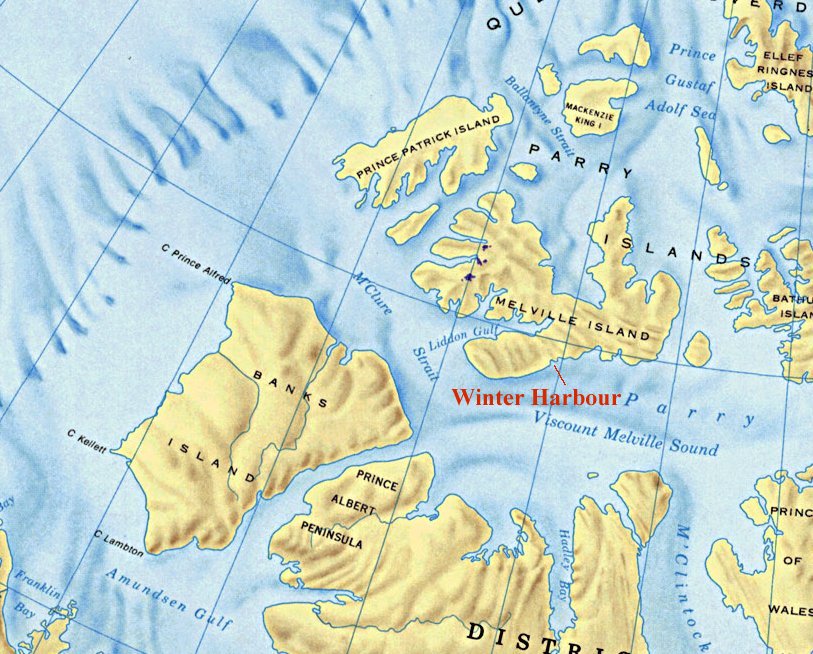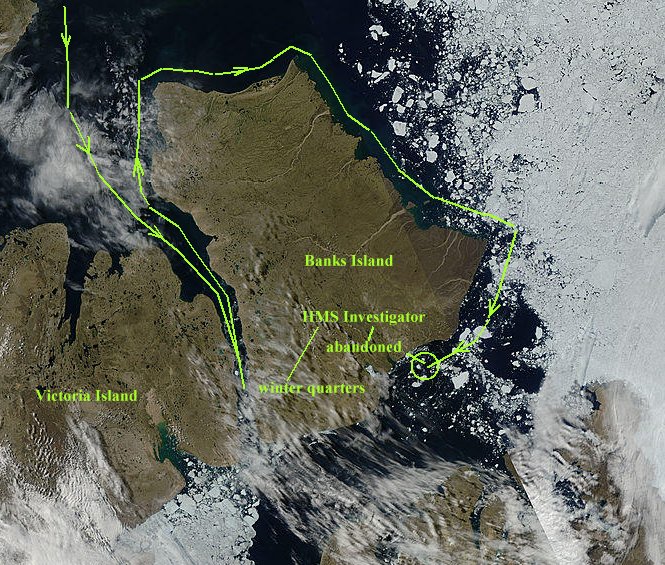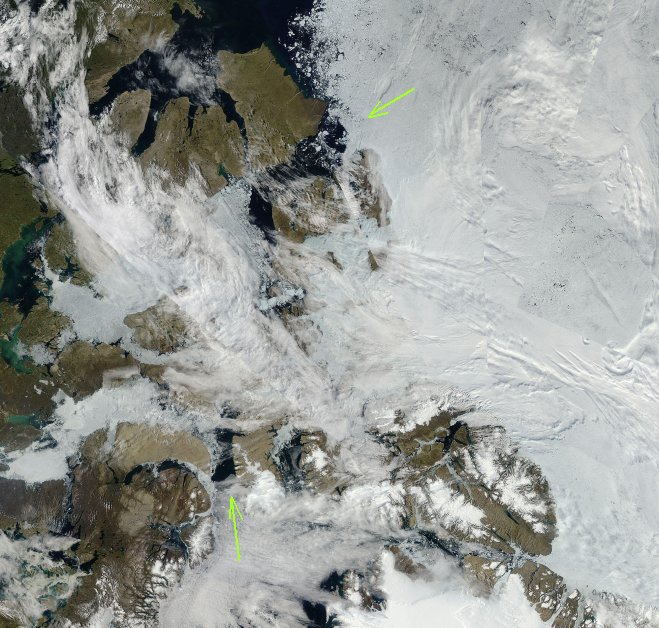Robert McClure and his crew were the first people to transit the North West Passage - by ship and sled. They were also the first to circumnavigate the Americas - by ships and sled.
McClure's ship - HMS Investigator - has just been found. She was abandoned in June 1853 due to a combination of factors: the general poor health of the crew; the uncertainty of escape from the ice; the availability of other vessels to take the crew home.
The story of how HMS Investigator came to be where it lies sunk today is a story of heroes trying to find a safe path for a ship through the permanent Arctic ice. As it turned out, this was an impossible task in the 1800s.
The British Government and Admiralty were keenly interested in finding a North West Passage through the Arctic. Following many expeditions up to 1845 only about 300 miles of the Arctic's Canadian main coastline remained to be surveyed. It seemed that if a passage existed it would soon be found. An expedition was mounted to survey the unknown areas. That was the Franklin Expedition. Sir John Franklin's expedition in the two ships HMS Erebus and HMS Terror was last seen in Melville Bay, 26 July 1845. And then the ships vanished, never to be seen again.
In 1847, with no word from the expedition, the Plover was provisioned and sent to Bering Strait in case the ships emerged after having found the North West passage. Two ships were acquired by the Royal Navy January 12 1848 and commissioned February 1 and 5 1848. Strange that the Resolution and Endeavour were built to Arctic qualities by two different shipyards just in time to be commissioned when needed. As Rear Admiral Noel Wright noted in his book Quest For Franklin: One likes to think someone had the forethought to order them "in advance of authority to purchase".
Those ships, with the Investigator and Enterprise, were used in the first major search for Franklin under Sir James Ross, 1848-1849. Robert McClure was First Lieutenant on HMS Enterprise during that search. He would have been familiar with the sailing qualities of both Enterprise and Investigator, a familiarity that apparently served him well later.

Robert McClure
The first searches for the Franklin Expedition focused on search and rescue. After all hope of finding survivors had faded, new expeditions were instructed to make surveys while searching for evidence of the lost expedition's fate.
Enterprise, Investigator and Admiralty orders
From an article in Quarterly Review 1852-53 - Search For Franklin
The ships of Sir James Ross were promptly refitted and despatched to Behring's Strait; the Enterprise commanded by Capt. Collinson, and the Investigator by M'Clure. They were instructed to sail with all speed, so as to pass the strait and reach the edge of the ice by the end of August.
...
This expedition left Plymouth on the 20th January, 1850. The ships communicated with the Herald, and Kellett assures the Arctic Committee of 1851, that, from a conversation he had with M'Clure -
' I am convinced that he will use every endeavour to reach Melville Island with his parties, if he failed with his ship. Should one of these parties reach Melville Island, or even the northern shore of Banks' land, they will endeavour to get home by the east, being a safer route than attempting to return to their ships.'
This statement is confirmed by the official and private letters of M'Clure. To Sir George Back, in particular, he states, in a letter of July 28, 1850, that he has carte blanche from Collinson, and that he is determined to push to the eastward to reach 130' W. long., and take his chance of wintering in the pack wherever he may be caught by the ice. These brave commanders had no sooner joined the Plover than they earnestly set to work to fulfil their mission. M'Clure outsailed Collinson and was last seen by the Plover (August, 1850), in lat. 70o 44' N., long. 159o 52' W. M'Clure calculated that he might make Banks' Land, get to the northward of Melville Island, and perhaps pass to the S.E. by Wellington Channel, or some other passage, so as to return home at latest in 1853. To the Admiralty he says that, should he find no navigable channel after pushing ahead for two seasons, he intends to desert his vessel on the third, and start on foot for Melville Island and Leopold Harbour. It is impossible not to admire his energy and daring. But knowing how completely the plans of the most able and resolute are at the mercy of the seasons in those latitudes, we cannot accept his courage as a pledge of his success, nor avoid feeling already some misgiving for his fate. Capt. Collinson, after penetrating some distance to the N. and E. of the strait, repassed it to winter at Hong Kong, the Plover being left in reserve at Port Clarence, in the strait. The Enterprise again quitted Hong Kong in May, 1851, reached Port Clarence, and left that port on 10th. July to renew her explorations to the north-east.
We have no intelligence of M'Clure since, under a press of canvas, he stood for the pack-ice off Icy Cape, in August, 1850 ; nor from Collinson since he passed Behring's Strait in July of the following year. Our consul at Panama indeed writes that Collinson had been spoken by some whalers, but, without details, we know not what credit is to be attached to the report. M'Clure supposed he should be able to reach England by way of Barrow's Strait some time in this year, either by navigating his vessel through the unknown sea which stretches north of the American continent, or by quitting his ship and making for Melville Island, or some point nearer home. Stirring tidings of some kind will most likely reach us in the course of a few months.
Stirring tidings did indeed reach England, but not in the few months anticipated by the article's author.
I mentioned that McClure had experience with both ships of the expedition. Supposedly the Enterprise was faster, and supposedly the two ships were required to stay together. The Admiralty orders were that the two ships were to sail in consort and never to separate unless constrained to do so. Like so many bold seamen before and since, McClure was not one to let any ambiguity in his orders pass by as an opportunity ungrasped.
The two ships had sailed from England to the Magellan Straits where a steamer waited to tow them through. This was presumably a safeguard against contrary winds, the Enterprise and Investigator being sailing ships and the winds in the region being notably contrary. The last orders given to McClure in HMS Investigator by his superior Captain Richard Collinson in HMS Enterprise were to rendezvous at Kotzebue Bay Alaska, or failing that, Cape Lisburne. Captain Collinson then pushed on ahead in the Enterprise.
Collinson may well have wished HMS Enterprise to be the first ship to boldly go where no ship had gone before, but he was thwarted. McClure found some more ambiguities in his detailed orders from the Admiralty. He formulated an interpretation of his orders worthy of any lawyer and determined that the plain wording of his instructions meant the exact opposite of what was written. Instructions which required him not to undertake geographical explorations also required him to reach Winter Harbor, Melville Island.

Winter Harbor, Melville Island
Nobody had ever reached Melville Island before except via Baffin Bay. The Enterprise and Investigator were to reach it via Bering Strait. It follows that the two ships were instructed to find a route from Bering Strait to Viscount Melville Sound and thus demonstrate the existence of the fabled North West Passage.
McClure may have been aware of Collinson's intention to leave the ostensibly slower Investigator behind and proceed with the supply ship Plover in consort. As the Enterprise sailed her fairly easy course through the Aleutians, McClure took a shorter but less safe route and gave Enterprise the slip.
Arrived at Kotzebue Bay ahead of Enterprise, McClure officially assumed that the faster ship was ahead of him, and stated as much in a letter to the Admiralty handed to Commander Maguire of the Plover. Setting of "in pursuit of Enterprise" McClure met the Herald past Cape Lisburne. Her captain, Henry Kellett, was not convinced that Enterprise had gone ahead, but permitted McClure to proceed. He then changed his mind, gave chase and signaled "Had you not better wait forty-eight hours?". McClure replied: "Important duty. Cannot upon my own responsibility" and then out-sailed the Herald.
The story is long, but this article need not be. McClure sailed with no great difficulty as far as Banks Island. He nearly reached the end of Prince of Wales Strait but was confronted by impenetrable ice. The Investigator wintered at that point in 1850-1851. Early in 1851 a sledge party led by McClure went to the end of Prince of Wales Strait and identified Melville Island across the Strait which now bears his name. The existence of a North West Passage had been proven.
When the ice melted, the obstruction at the end of the strait held fast. McClure then determined to try for the main strait via a circumnavigation of Banks Island. Along the north coast the inshore lead was so narrow and so close inshore that the studding sails had to be taken in. These sails extend sideways from the main sail area and overhang the ship's sides. At one point the ice had to be blasted to make a passage. Finally, as the winter freeze began, just when it looked like the ship would be frozen in, a safe haven for winter was found. McClure named it Mercy Bay.
The ship lies there still.

Investigator's last voyage
This MODIS image shows freely navigable waters in July 2010. Those same waters were virtually impenetrable in the 1800s. Even as late as August, navigation was possible only via the occasional open lead and the judicious use of ice saws and explosives.
By 1853 it appeared that the Investigator crew would have to abandon ship and march south. Preparations were made, but in April 1853 Lieutenant Pim of the Resolute appeared with a sledging party. The crew were marched to HMS resolute, but she in turn was abandoned to her fate. At one time five crews of abandoned ships were crowded aboard the Pole Star. Fortunately two other ships appeared in time to redistribute the rescued men before the journey home to England.
Thus it was that Robert McClure and his crew were the first to transit the North West Passage and first to circumnavigate the Americas - mainly in HMS Investigator but also in other ships and over the ice on foot.
The long-awaited 'stirring tidings' led to a knighthood for Robert McClure from the queen and a cash reward of GBP 5,000 voted by parliament. The crew shared a further GBP 5,000 - a huge sum in those days.
The North West Passage was first navigated entirely by sea and in one ship only when Roald Amundsen took his tiny Gjoa through a southerly route east to west during the three years 1903 to 1906. The hazards were many, and wintering in the ice essential.
The RCMP vessel St. Roch navigated the southerly route west to east with wintering in the ice during 1940 to 1942. In 1944 she became the first vessel to complete the passage in one season, sailing via the main North West Passage discovered by Robert McClure.

North West Passage July 2010
The green arrows indicate the main passage. Banks Island is top center of image.
The Arctic of 2010 bears little resemblance to the Arctic that 19th century explorers encountered. Most of the ancient ice shelves are gone. Most of the thick shorebound multi-year ice is gone. Most multi-year ice in the main pack is gone.
The North West and North East Passages look to be freely navigable soon. An ice free Canadian Archipelago and a circumnavigable Greenland are becoming ever more plausible.
The wreck of HMS Investigator has been discovered only because she is no longer hidden beneath what was once considered the Arctic's eternal ice..
----------------------------------------------------------------
More Arctic Heroes:
Arctic Heroes #1 - Alfred Wegener
Arctic Heroes #2 - North Pole 1
More Arctic-themed articles:
The ChatterBox Arctic Index




Comments